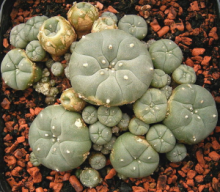Article
The belief system upon which the Native American Church is established. Founded in 1918 as a Pan-Indian movement and in response to government abuses and relocations, the Native American Church synthesized Christian faith and principles with the sacramental use of peyote, a small, spineless cactus that grows primarily in Texas and Mexico and that is known as a hallucinogen. Although using peyote for ceremonial purposes occurred in many tribes prior to the organization of the Church, the Native American Church is the first, large ceremonial organization to transcend tribal differences. The Church still exists today despite U.S. legal objection to the use of peyote, which is classified as an illegal drug.
Peyote ceremonies, intended for healing and blessing, usually take place on weekends, but there is no set schedule. Some groups hold meetings monthly while others are more spontaneous. Because peyote is psychoactive, service participants often have visions, but it is the community experience of these effects that gives the ceremony spiritual power.
"Peyote cactus (Lophophora williamsii), February 18, 2007" by Frank Vincentz is licensed under CC BY-SA.
Manuscripts
References
Aberle, David Friend
1983 Peyote Religion among the Navajo. In Handbook Of North American Indians:
Southwest. Alfonso Ortiz, ed. Washington, D. C.: Smithsonian Institution.
Paper, Jordan
2014 Native American Church. The American Mosaic: The American Indian Experience.
http://americanindian2.abc-clio.com/Search/Display/1482221?terms=native…, accessed
June 27, 2014.

